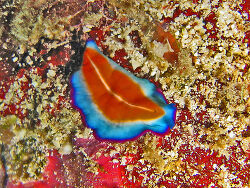Info
Pseudoceros susanae Newman & Anderson, 1997
Pseudoceros susanae is one of approximately 150 Pseudoceros species. It is probably the most common flatworm in the Maldives. As a rule, Pseudoceros species are food specialists who cannot find sufficient food in the aquarium in the long term.
Pseudoceros susanae is a larger flatworm with a length of up to 5.5 cm. It has an oval shape. The body is light blue. This blue color is sometimes (not always) downgraded from a white central area and extends to the edge. The latter is often darker, purple to dark red.
There is an orange stripe down the middle of the back, always marked at its center by a thin white line. This orange stripe, which is more or less wide depending on the individual, begins behind the eyespot and ends in front of the rear end of the flatworm without reaching the edges.
At the front of the animal, the folds of the body form two simple pseudotentacles which are colored in the same blue as the body and have the possible color of the edge.
Many of these species feed primarily on sea squirts, bryozoans, small lower animals of all kinds, but also on the mucus or surface tissue of soft corals. They are often very good swimmers and look elegant while doing so.
Pseudoceros susanae is one of approximately 150 Pseudoceros species. It is probably the most common flatworm in the Maldives. As a rule, Pseudoceros species are food specialists who cannot find sufficient food in the aquarium in the long term.
Pseudoceros susanae is a larger flatworm with a length of up to 5.5 cm. It has an oval shape. The body is light blue. This blue color is sometimes (not always) downgraded from a white central area and extends to the edge. The latter is often darker, purple to dark red.
There is an orange stripe down the middle of the back, always marked at its center by a thin white line. This orange stripe, which is more or less wide depending on the individual, begins behind the eyespot and ends in front of the rear end of the flatworm without reaching the edges.
At the front of the animal, the folds of the body form two simple pseudotentacles which are colored in the same blue as the body and have the possible color of the edge.
Many of these species feed primarily on sea squirts, bryozoans, small lower animals of all kinds, but also on the mucus or surface tissue of soft corals. They are often very good swimmers and look elegant while doing so.







 Karen Honeycutt, USA
Karen Honeycutt, USA






























































































